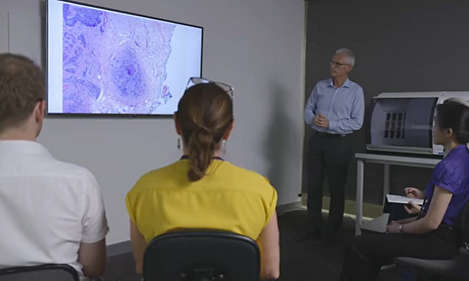USCAP 2024 Symposium
By Philips ∙ March 25, 2024 ∙ 1:37 min
At-a-glance
[1:08] ∙ Dr. William Westra discusses how Sinai Health digitizes 2 million slides annually and makes them available across a wide geographic network for diagnosis, training and collaboration. [19:53] ∙ Dr. Anil Parwani explains how real-time access to digital slides and digital pathology tools, including AI, impact patient care at The Ohio State University. [46:47] ∙ Dr. Andrew Evans shares how he and his team implemented digital pathology in a community practice and explains the business case for implementation.
In a symposium held at the United States and Canadian Academy of Pathology meeting, three users of Philips digital pathology solution discussed their experiences switching to a digital system. With the largest digital pathology installed base in the world, the Philips proven and scalable solution includes scanners to digitize slides and the IntelliSite Image Management System, which combines a viewer, server and storage application. This solution can be integrated with enterprise-wide IT infrastructure and AI capabilities*, to deliver cost-effective productivity and efficiency gains.** Dr. Willaim Westra began by outlining the scope of the transition to digital pathology at Mount Sinai Health System, which scans approximately 2 million slides annually. He noted that digital capabilities make collaboration and education easier. “Unlike the past, where we would crowd all of our residents around a multi-headed scope, I now can give conferences system-wide throughout all of those hospitals using the digital pathology platform,” he said. “I would argue that digital pathology, in terms of resident/fellow education, is more than just a tool of convenience. It's becoming a tool almost of obligation for the way it supports the NIH mission towards advancing translational research through bringing up the next generation of pathology residents and fellows. The same concept applies for tumor boards or if a clinician or surgeon has a question about any case regarding pathology. I can just pull up those images and then share with colleagues.”
Mount Sinai experiences easier collaboration and faster turnaround
“I would argue that digital pathology, in terms of resident/fellow education, is more than just a tool of convenience. It's becoming almost a tool of obligation.”
&mask=is(Philips/circle?fit=fit,1&wid=480)&wid=480&hei=480&fmt=png-alpha)
Dr. William Westra
MD, Professor and Vice Chair of Pathology Mount Sinai Health System New York, NY, USA
Sinai Health’s digital pathology platform has also reduced turnaround times. “The digital console is very fast compared to glass slide service,” Westra said. “We've dramatically reduced turnaround time from several days to literally just a few hours.”
The Ohio State University uses digital pathology to aid multi-site research
The Ohio State University built an off-site histology lab that makes scanned slides available to pathologists in real-time. Dr. Anil Parwani noted that the move to digital did not result in any image degradation and provided new tools.
“We have a lot of tools in the image management system today: viewing tools, zooming, side-by-side, registration and manipulations,” Parwani pointed out. “It has opened more doors than a glass slide would. Once you digitize (a slide) you extend that life of the image. It doesn't fade or get broken or lost.”
He also appreciates how digital pathology aids research. “We have interactive tools for researchers and we’re not confined to one location,” Parwani said. “I'm doing research projects in India, Japan and China because of this technology. Research images are available 24/7, so we're creating data sets and research for successful academic and industry partnerships.”
“Once you digitize (a slide) you extend that life of the image. It doesn't fade or get broken or lost.”
&mask=is(Philips/circle?fit=fit,1&wid=480)&wid=480&hei=480&fmt=png-alpha)
Dr. Anil Parwani
MD, PhD Professor of Pathology and Vice Chair and Director of Anatomical Pathology The Ohio State University Columbus, OH, USA
Mackenzie Health sees digital pathology as an essential platform for the future
Andrew Evans is a pathologist at Mackenzie Health, a two-site community hospital in Richmond Hill, Ontario. He emphasized that implementation of digital pathology is institution-specific. “It’s not a one-size-fits-all template,” he said. He added that assessing its worth cannot be based on return-on-investment, but requires assessing what you can do with the technology. Evans said leadership at Mackenzie Health “embraced and adopted the idea that digital pathology is the new paradigm for the specialty. It's a required tool for contemporary practice going forward and an essential platform on which to implement AI and build in other strategies.”
“Digital pathology implementation is very much an institution-specific exercise. It's not a one-size fits-all template.”
&mask=is(Philips/circle?fit=fit,1&wid=480)&wid=480&hei=480&fmt=png-alpha)
Dr. Andrew Evans
MD, PhD, Medical Director of Laboratory Medicine MacKenzie Health Richmond Hill, Ontario, Canada
“We are currently leveraging the digital pathology platform to investigate how we could integrate AI into a community practice setting,” he added. “We've had a chance to evaluate a few of these tools but none of them are validated or verified on Mackenzie Health cases. So, we're not actually using them for patient care but that will soon follow.”
Footnotes
[1] Survey of 52 pathologists, lab managers and lab technicians in Europe, 2018 Results are specific to the institution where they were obtained and may not reflect the results achievable at other institutions * PIPS enables iSyntax files and with the Software Development Kit (SDK) third-party companies can use this for AI capabilities. ** Philips’ pathology solution in combination with Ibex Medical Analytics’ Galen™ AI diagnostics platform, which generates objective, reproducible results, increases diagnostic confidence, and enables productivity and efficiency improvements.






